#made this in a two hour burst of creativity based on an outline of a poem i made a while ago
Explore tagged Tumblr posts
Text
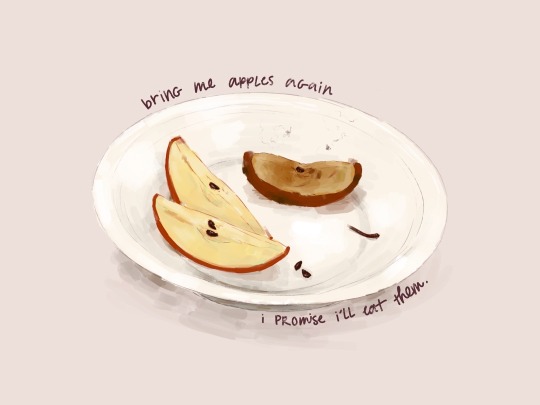
dear dad,
#click for better quality!#made this in a two hour burst of creativity based on an outline of a poem i made a while ago#neena.art#art#digital art#digital painting#apples#fruit art#poetry#vent art#vaguely?#artists on tumblr#procreate art#friendshapedcastiel#sirlampselot#userdorksinlove#useranny#soperiso#trenchcoatag#mishavacado#sorry guys ik this isn’t my usual stuff 🫶
149 notes
·
View notes
Text
creative claims verification — omen
summary: gyujeong writes this song inside bc’s dungeon, and he’s angry lol warnings: none wc: 1848, lyrics not included
it goes all like the cliches say — the brooding artist inside the depths of some studio, how ever many floors up chungdam’s heart. there’s packs of cigarettes sprawled, each one a witness to hours on end frustration and a bottle of empty hennessy that gives the allusion that he’s a begging drunk starved for a taste of inspiration.
except, he’s no brooding artist. fuck, if he’s had a say. not distressed by bits of artistic rage or stumped creativity. he’s a fucking sell out, a bitch of a sham. the end seat giving the moniker of some rapper who’s had his stomach full, throat quenched by the delicacies of what life has to offer.
hennessy, and he’s a liar to admit he’s grown accustomed to the taste of johnnie walker. but what’s he to say when alcohol all tastes like the droplets of acrid bitterness, and the drunken verge still comes within one and half glass.
it’s the same, he’s the same.
there’s a beat in his heart that rages on — the sounds of something easy, the sounds of kanye that sprawl out influences on him. he takes music like the gospel, holy and sacred to the notes of his heart. it’s a chord, a simple reverb of ‘omen’ high pitched, repeating the title he keeps closer to his heart. it’s always been an omen — a premonition that crawls low, underneath his skin. it’s the tingle in his spine that etches itself, forcing his knees to bend. succumb, on the floor as his eyes wander up to a light that no longer torches bright.
there’s a darkness inside the first few hits of the notes. all sullen, hidden heavy. muted in the background — nothing casual, just a loom that pries like a breach into his soul. if sanctuaries could talk, they’d speak nothing but the doomed echoes of dulled out chords of an organ.
but he’s crafted too many sins out a dead-end career, and the organ trades itself for manic ivories. he presses the keys in sync, a steadiness his hands hold. a chord? if he’s said much, it sounds more like two keys no harmonies. just the pure off-put, shamming itself to be a cacophony behind the reverb of voices, chopped and screwed. pulled low, distorted. maybe, he just wants to be haunted — feel the remains, and each word wielded together like weaponry, poised and aimed towards him.
been there done that, the scram of diss tracks aimed towards his title — the rapper of knight. a rapper? the word no longer holds validity, more like the satire that screeches on when he grimaces a bit in the tongue and cheek chuckle bursting open when he can barely manage to decipher his reflection in the mirror. hands clasped, this isn’t a sanctuary, it’s a full on warzone where he’s out in the open. publicity stand with fingers pointed, a full-on exposed target with no way to bite back, and a label that acts more as an oppressor than an ally.
his fingers gauge on the beat, finger taps against the wooden table that he’s carved his name into. dead pressed cigarettes, it’s simple. steadiness, nothing more than the shoddy backtrack of a barren base. the empty hollow vessel, shaping the outlines of a song — but when has he ever made it anything that needs sheer opulence to decorate the pews he’s built with his blood and bones? his chin dips, a crack of a smile. it’s restlessness riding on the echoes of a lonely studio. an ode to the notion that he’s never needed more than loose stares and the act of writing himself off. they wouldn’t understand, not the ones back home nor the ones here — a black sheep, at best. it’s his take at a one handed track where his voice takes reign on the words he’s never been able to entrance to the empty room.
it starts like it always has. the monotonous beat on loop, the continuation. his hands on the keyboard that pulls up an empty note page — what fills the empty blinking cursor is the distaste. the venom he wants to spew to poison the ears of underestimation.
eight years oppressed. eight years, a bitch inside a company. eight years, a sell out. bright eyes for a child inside the misfit basement of the underground scene, scribbling out the name for himself when he’s buried the moniker of ‘chung’ six feet under with no way out. haon — a rebirth, yet only becomes tainted by the image of frills with no thrills on stage. real recognize real? a fact that only becomes when they’re all lined by the same struggles, self-centered and self-occupied. too focused on a one-track road of success, but his lane’s been iced over — cold. frigid brush ins tacked with the sardonic laughs that spew when his title’s been stripped by the hands of bc.
hustlers only recognize hustlers but only gave each other the cold shoulder
a contract signed, and the string of malicious tracks. neutrality bc takes, bare in their response. and an even emptier hand on the public outcry — he’s only ever had himself through each maze of scandal. neutrality benefits the repressor, and he’s been a victim. diss tracks upon diss tracks, and his crew no longer has their back — silenced and omitted by a company that skews his history for what it is at face value. in this case, he takes it to the wise words of elie wiesel.
neutral benefits only the repressor, not the victim in all other words, all who are silent are the repressor quote elie wiesel
life’s always been this — he types away. the irony comes from a cursed life in a golden spoon, taught and mangled with the manners that never fall far from the tree. the only idiot that hasn’t had the decency to bite back, draw his poison in to drag the oppressors ten feet below. he’s been alone, managed his own tricks to mold out of what he has left. the last morsels of dignity fueling the deadly glares in how he spits to an empty target.
my cursed life that resonated with that quote i’m the only idiot that doesn’t litter cigarettes so i spat and glared to survive the dumbasses, peer pressured
anger goes the more he lets on, the more his thoughts process and align into coherencies. a line he draws in a pure division of them versus me — a motherfucker be it, he’ll call himself. trampled on, a motherfucker he’ll remain with nothing to assess — they’ll call him what they want, a sell out. he’ll give them his worth in the flow even they know they won’t match.
minuscule presence in the grand scheme of nothings, a baseless stage with fingers pointed. on camera as a ddandara of knight, he realizes how fucking stupid he looks when he’s dwindled down to nothing more than chokers and black leather. still to those that give him the doubt that comes from his bones — he salutes the middle finger. a self-proclaimed napoleon — after all, they’re the same bitches pegging him as a hero, war-crazy set forth on a pedestal. denial’s pathetic, he deems them worthless.
yeah, i’m changed motherfucker not like them motherfucker i’m still a motherfucker you nagging ass motherfuckers
they’re all phonies playing on the grr-kaws, and pews. the sounds where the words don’t make up the brunt of the fight — skills ablated. bang for buck, they can’t seize him in a corner with the centered life of hip-hop rhymes and flows. and inside bc? becomes a haywire empire of money and calculated movements, music that knows only the boundaries they settle in the dusk. and he’s tired of running his mouth, saving case for something far off like an omnipresent omen. the cut corners, he craves the dead-center words spoken straight to his face.
the fucks your problem, tell me all of it my tongue is exhausted
it’s all fucking politics by the end, and the song writes itself. it’s the lyrics that give way to the praised seat at the end of radio star — a seat he’s held himself. a fucking sham, sell-out disgrace. maybe public outcries in the right, and what he’s left to do is drop it at face value and retire from the scene. underground or in high spotlight — there’s one thing that lingers: he’ll eat them all up, dead or alive before he leaves. a hungry monster that reaches out, he’s never been set for the pews of a church. hell is a warm place, and perhaps — it’s his calling for a home.
complain like a bitch, but you all can’t make music for shit
it’s the last go, when he looks through the lyrics written.
a steady rhyme in each verse, music still on loop. it’s here he mixes and matches the punch of flows, rapping along in tandem with the beat strung out. shit beats him, and he’ll make his own grave with a one-way ticket to hell if he doesn’t finish here.
and what becomes is the next string of auto pilot: the movement of headphones pressed straight to his head, an omission for the recording booth in lieu of the mic he pulls forward. a 70,000 mic — a gift that comes from the first scope into the underground seeds sown. if this was the start of mockery, now it becomes a full-on war of direct hits.
he hits the red button that follows the clicks of a metronome holding him steady. there’s alcohol lingering on his tongue, and a face tinged with red that alludes to the reverie of anguish that lodges itself deep in his throat. void of nicotine, he’s restless the way his fingers tap against his knees and the way his toes hit the ground below. a one take, and he rolls with the punches where the beginning of the track comes as screams pulled soul heavy. lung deep.
the grittiness of his voice bleeds desperation, the lowlife shadows sunk, and he blames the innocent nostalgia that plagues the souls around him and before him. hell lets loose when he spits the first verse, inspired? no. fueled by the rage that he unclaws for the sake of his sanity.
it doesn’t stop, nonetheless pause when he’s hit the mic. suddenly, home becomes him and the emptiness of the beat, where his words flow louder than the punch of any bass. no snarls or drums, he wants the flow to carry the tides and rage a natural disaster of a hurricane to take the speakers in.
it’s the vision he has in mind of the track to take the hearts of every person who’s ever questioned. doubted. pointed fingers into the background he’s left in the past. and to the poor souls of his past who continuously paint him as a disgrace to their home. a question into the world he lives, he tells them to fuck off — a motherfucker he’ll always be despite any step that comes forward or trips him back. it’s his ode and one-two take of cutting goodbyes, and raising the only thing he’s never known — middle finger in the air, he gives them a fuck you.
“fuck all of you” is his last farewell to the end. half caught on a record, half end by the time the mouse click signifies the complete end.
another track buried in the hard drive of his own makeshift graveyard, and he’s realized he’s never been in the empty church. he was in hell all along.
4 notes
·
View notes
Text
Ranking Every Studio Ghibli Movie
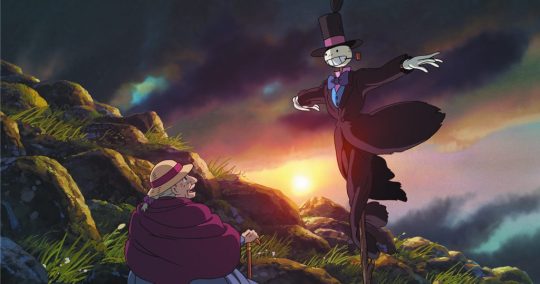
Studio Ghibli's contribution to anime (and animation in general) cannot be understated. Founded by directors Hayao Miyazaki and Isao Takahata, and producer Toshio Suzuki, the studio has produced many of Japan's most hallowed films, movies that are both critically acclaimed and monsters at the box office. In 1996, Disney partnered with Studio Ghibli to bring their movies to North America, developing a new audience that has since come to age; now, Ghibli is as much a part of American childhood as Pixar and Dreamworks releases.
On Anime Pop Heart and @beneaththetangles, we are commemorating the studio with Ghibli Month all September long! I’m kicking things off by ranking Ghibli's twenty-one releases, plus Nausicaa of the Valley of the Wind, which is often honorarily included among the studio's slate, ranked from first to worst (including alternate viewpoints on a couple of the selections).
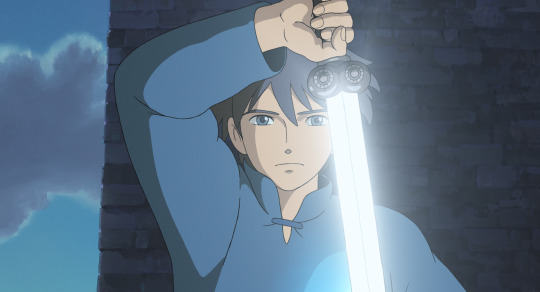
22. Tales from Earthsea
Miyazaki famously quarreled with his son, Goro, over the latter's ability to direct Tales from Earthsea, and indeeed, the final product feels like the result of a young man who was in over his head. The movie deserves its ignominious reputation, as it is inconsistent, poorly staged, and often terrible. It's a shame, too, for there are some strong elements to the film and enormous potential, with the outlines of an epic tale and compelling characters in Sparrowhawk and Cob (who are wonderfully dubbed by Timothy Dalton and Willem Dafoe, respectively)—it just never comes quite together and totally unravels at the end, resulting in the only bad film in Studio Ghibli's outstanding run.

21. The Cat Returns
Most Studio Ghibli films are family features, made for children. However, they still capture the imagination of youth and adults as well. The Cat Returns, the only "sequel" in Ghibli's film catalog, doesn't do the same however. It is purely for kids, and aside from flourishes here and there that speak of fantasy adventures and feature whimsical characters, fails to engage viewers of a certain age—maybe anyone older than about twelve. A neat companion piece to Whisper of the Heart, it's worth watching, showing to your children, and then giving away to parents who need better-than-average entertainment to busy their children.
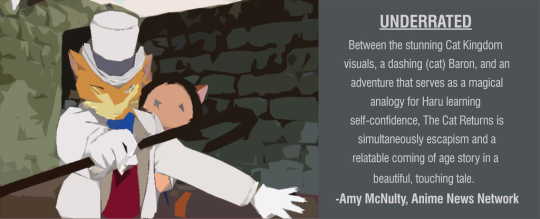
20. Ocean Waves
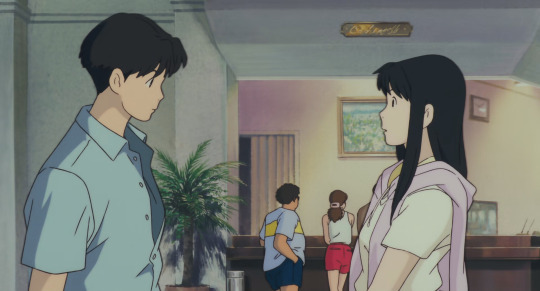
At one time, Ocean Waves was considered a black eye in Ghibli's filmography, an overpriced television movie that wasn't all that good. In retrospect, the intial judgments were only partially right. Ocean Waves is very much a TV movie, melodramatic and small in scale. The animation, too, is sometimes shoddy, but more often than not it's far better than it has the right to be. Ocean Waves is lovingly made, and the characters are almost frustratingly sincere—and oh so early 90s. While on the lowest tier of the Ghibli scale, Ocean Waves is far better than a simple curiosity.
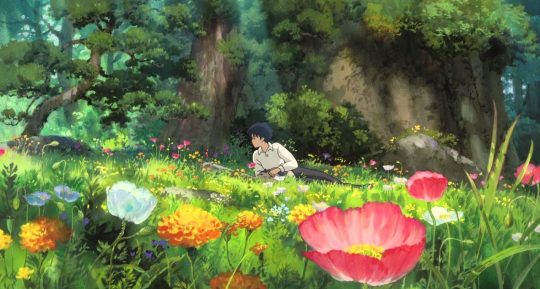
19. Arrietty
Like Poppy Hill before it, there's nothing terrifically wrong with Arrietty—it just lacks the magic of the great Studio Ghibli films, making it rather forgettable. It's also sometimes dull. While beautiful colors, a foreshadowing of the spectacular animation to come of Yonebayashi in Mary and the Witch's Flower, shine through in the film, and some of the action sequences are highly engaging, our hearts are never fully in it. Maybe that's because we lack a loving connection to many of the characters, particularly to the pensive Sho. A nice watch, but one that's lacking.
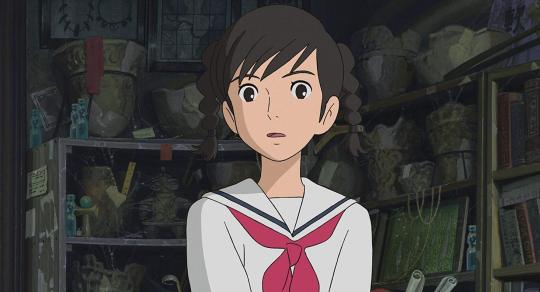
18. From Up on Poppy Hill
Much maligned for our lowest ranked movie, Goro Miyazaki returned from that entry with a stronger film, one that functions as an ode to historic preservation while presenting one of the studio's most lovely relationships—that is, until it gets a bit tricky, unfortunately begining to enter a zone unusual for Studio Ghibli, if standard fare for other anime. But that's a relatively minor issue in what's a perfectly lovely film that does well in evoking nostalgia in a movie that reminisces about the past and a Yokohama that no longer exists. Not every emotional moment hits as it should, but enough do to make the film Ghibli's best "date night" entry.
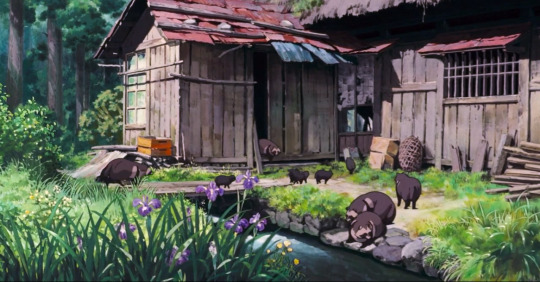
17. Pom Poko
Often criticized for being too over-bearing in its ecological message, Pom Poko's main issue instead is that it's meant to a collection of stories that to flow into one another, based on one group of tanukis' fight against urban development, but the movie doesn't feel cohesive, partly because there is no central protagonist. We only get to know each main tanuki so much, and none feel central to the tale—any could step in and play the necessary roles. Still, Pom Poko is unreservedly charming and often hilarious. It's also a peek into Japanese culture that we often don't get, a look at a country transforming in landscape and in values.
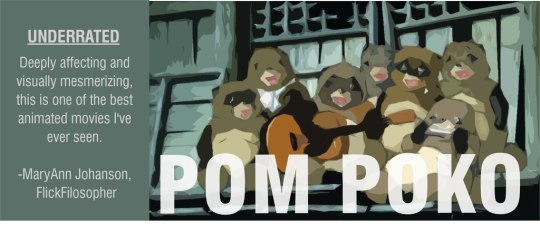
16. Ponyo
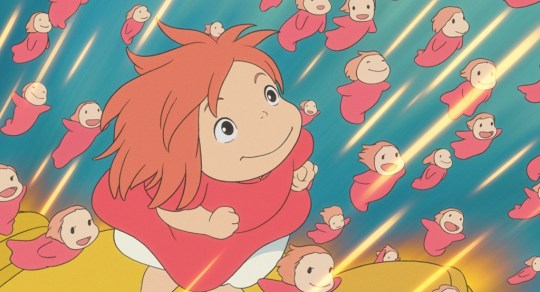
Why is Ponyo the low point of Miyazaki's output, the only film of his that doesn't attain the level of classic? It is wonderfully animated, bursting with energy and featuring a story that is never disingenuous and a heroine that is funny, cute, and breathtaking even. However, the film proved that Miyazaki was on a downward trajectory after Spirited Away. Repetition seen in Howl's Moving Castle was on full display in Ponyo, a new movie that too often feels like a rehash, featuring characters that other than the title heroine, fail to connect, and a story that is muddled and often just strange. Ponyo is a fun film and a better one after repeated viewings—the problem is that such defenses do not have to be made for any of Miyazaki's other works.
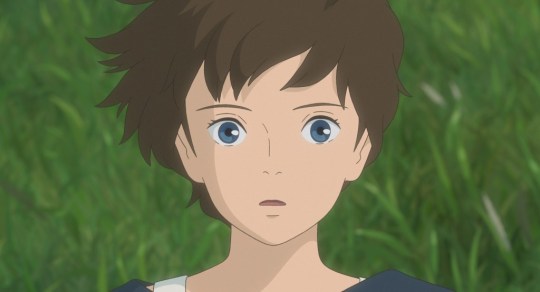
15. When Marnie Was There
The last feature film from Studio Ghibli to date is both quietly personal and a surprising risk. When Marnie Was There is the studio's first true mystery tale, and has a tone that's slightly haunting. The lead characters, also, are unusual for Ghibli—neither Anna nor Marnie are as embraceable as most of the heroines from Ghibli's past, but that seems be purposeful. What they demonstrate to us is not as much of "who we can be" but "who we are" and even so, how we can overcome. The creative energy of past Ghibli films is missing, but the replacement here by a surprising intimate tone in a modern setting is welcomed.
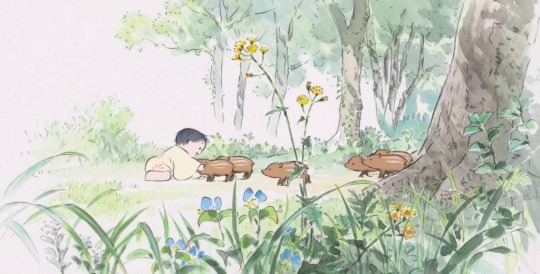
14. The Tale of the Princess Kaguya
While this notoriously expensive film flopped at the box office, The Tale of the Princess Kaguya was well-received by critics, and for good reason. Adapting a famed folk tale, the film is animated in style befitting its origins, creating the sense that the viewer has fallen into a some traditional Japanese painting. But the movie is not as pastel as its colors indicate—the storytelling is bold. It doesn't sit in the past, instead feeling remarkably current in the fable of a princess imprisoned by seemingly everyone and everything, without ever feeling worn or heavy-handed. Mystical and fantastical elements are both woven into the foundation of the story and come alive in key moments, keeping the film compelling (for the most part) throughout its two hour+ run time.
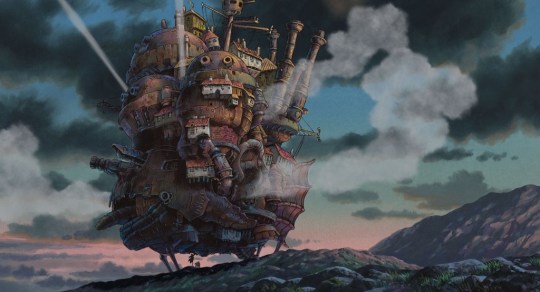
13. Howl's Moving Castle
An underrated aspect of Studio Ghibli's brilliance is in how they often adapt already-beloved works. Adapted by the master, Howl's Moving Castle, based on the novel by Diana Wynne Jones, is gorgeously animated and bold in both design and character—Howl and Calcifer, particularly, are memorable (and give strong emotional weight to the tale). While it suffers in comparison to its predecessor, Spirited Away, by being a little unwieldy, it remains a classic and an example of how well Miyazaki can bring themes and plot points across subtly (think of the flashback of Howl) in a movie that's otherwise fierce and larger than life.
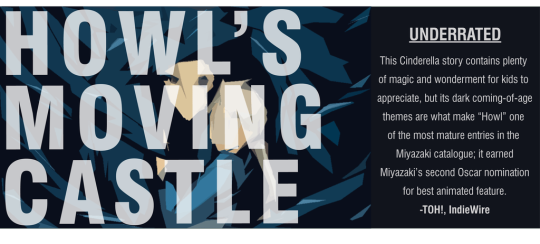
12. The Wind Rises

From conception, The Wind Rises was a challenging film—how do you tell the story of the man who designed a fighter essential to Japan's WWI efforts, and show him as a patriot and dreamer without excluding the crimes of the nation, or making a film that goes against Miyazaki's anti-war values? It's difficult to say if he succeeds, but the film itself is beautifully crafted. The supporting characters here are less important than in other works, so it's vital that the audience admires Jiro Horikoshi, and we do—his character and positivity make him easy to root for, and dream sequences in the film both flesh out his thought process and keep us captivated. Once believed to be Miyazaki's last film, if it had been, The Wind Rises would have been worthy of that designation.
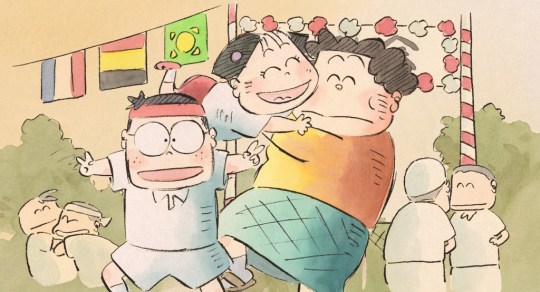
11. My Neighbors the Yamadas
The oddball in Ghibli's filmography, My Neighbors the Yamadas is presented through half-a-dozen or more short stories in the style of comic strips come to life, with animation that matches. The magic in the film is that the Yamadas are as over-the-top as the movie's aesthetic is, yet maintain an authentic feel. Think of some of the most popular family sitcoms of the 1980s and 1990s, but with an addition those shows could not feature—fantastical sequences that break in without warning and bind the ties of family further. We may not want to live like the clumsy Yamadas, but the heart of the family will make you consider whether they're the ones who really have it all together.
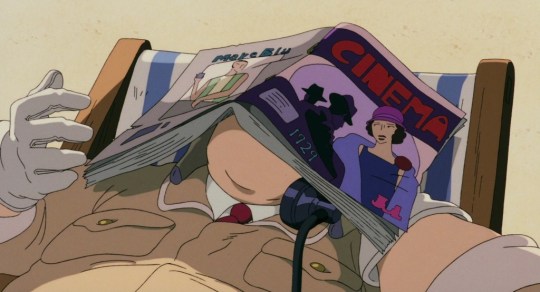
10. Porco Rosso
Studio Ghibli films share animation styles and themes, but one can never say they lack in variety when it comes to story. The tale of Porco Rosso is of an ace pilot cursed into living as a pig—but not to worry! He is still adored by women as he flies fantastic missions while running from fascists, pirates, and fame-seeking assassins. Porco is gruff and unattractive, but both he and the tale are sweet, as what's already a compelling story of WWI aces and dogfights is buffeted by grief, romance, and two strong heroines of very different types and roles. Perhaps the film with the largest range of opinion among the Miyazaki classics, Porco Rosso is nonetheless fantastic, and require viewing if you haven't watched it already.
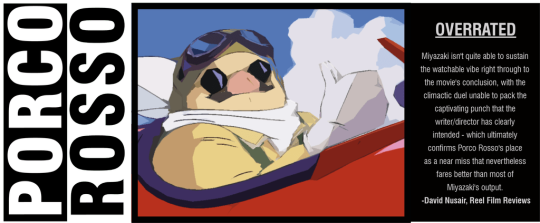
9. Whisper of the Heart
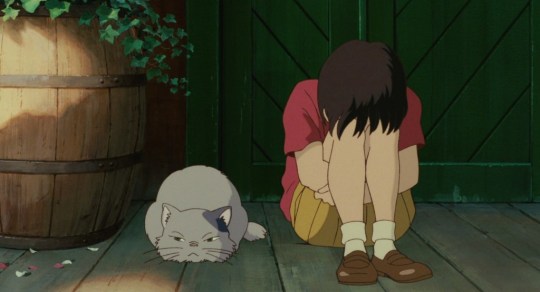
Ghibli's most unabashedly romantic film is one of its most formulaic, but still among its best. The debut film by Yoshifumi Kondō, Miyazaki and Takahata's proposed successor before he died just a few years after the movie's premiere, is at once encouraging while also refusing to shy away from the melancholy experienced by children—and adults, too—when one doesn't seem to have what it takes to become great. In joy and sadness, Whisper of the Heart lets the kids at the center of the film be kids. They are at times stubborn, silly, and immature, and by treating them that way, the movie never drifts into something banal (with the possible exception of the famously abrupt ending)—it's a lovely lesson in growing up and meeting challenges, and a personal favorite.
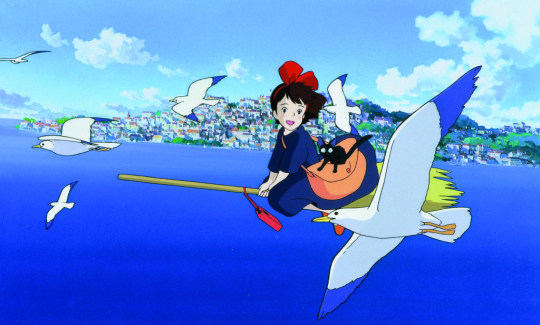
8. Kiki's Delivery Service
The charm of Kiki's Delivery Service is two-fold—in the setting, a northern European-style town that is alive, forcing the events of the story through its residents, cozy cafes, and early 20th-century transportion, and in Kiki's journey itself. Her community's tradition of sending of young witches to live by themselves at the age of thirteen sets the story in motion, and Miyazaki captures the spirit of a girl that age perfectly—in all its confusion, energy, enthusiasm, and difficulty. Kiki is not a subtle character, but her growth is. When she takes to the air for the finale, Kiki isn't experienced enough to know if she can save the day—and so we cheer when she realizes what the rest of us already know, what we've all experienced ourselves, that it takes time and failure to mold us into becoming the hero.
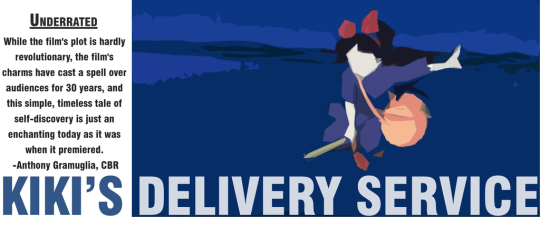
7. Castle in the Sky

Miyazaki created classic film after classic film for decades, in a streak that started with Lupin III and ended, I'd argue, with Howl's Moving Castle. Often forgotten among the wonders is Castle in the Sky, a steampunk entry that is a joyous adventure, akin to Treasure Island but developed for an audience of both boys and girls. Sumptuous cloudscapes fill the screen, as do colorful characters with meaty roles, including a group favored by Miyazaki—pirates (in this movie, air pirates led by Dola, an older female). Reflective of Miyazaki's ability to master genres, Castle in the Sky again crosses fantasy and sci-fi in perfect proportions, underscoring an uplifting tale with an apocalyptic story line.
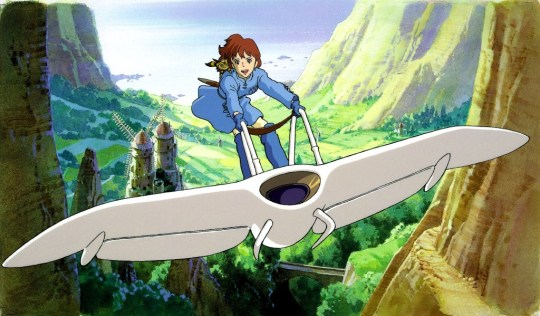
6. Nausicaa of the Valley of the Wind
Unofficially part of of Ghibli's canon, the success of Nausicaa, based on Miyazaki's own manga and exploring the ecological, anti-war, and feminist themes for which the studio's future films would be noted, launched Studio Ghibli. Nausicaa herself remains one of the studio's most iconic and compelling heroines, a physically powerful and feminine hero who must grow into adulthood very quickly while putting aside deep flaws to offer salvation to her people and land. The beautiful landscapes speaks to the epic story, better fleshed out in the manga, while reminding us that Ghibli films are giants not only in animation, but in fantasy and sci-fi realms as well.
5. Only Yesterday
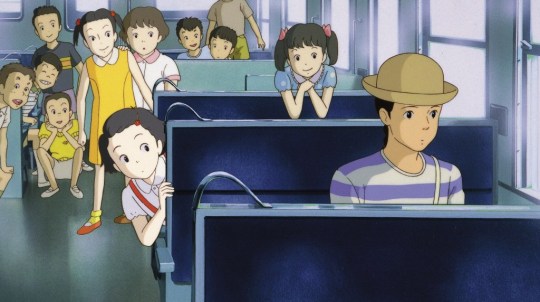
How do you create an animated film about a twenty-something woman that waxes nostalgia while on a trip to the countryside, and at the same time make it entertaining and accessible? It's not an easy task, but Only Yesterday accomplishes it fully. Taeko, the protagonist, explains, "I didn't intend for ten-year-old me to come on this trip, but somehow, once she showed up, she wouldn't leave me alone." We experience her nostalgia for and complicated feelings about the past through a family that's genuinely flawed, while experiencing her visit to relatives in the countryside in the present, a trip that is subtly life-altering, one that pushes her to consider who she is and who she wants to be. Oh, and the film also features one of anime's most wonderful endings, set to a cover of a now-classic love song.

4. Grave of the Fireflies
It's a testament to Miyazaki's stature that the first three Ghibli films on the list are all directed by him, and also to the supreme talent of the other directors that their films rise above some of his other tremendous work. Directed by Studio Ghibli co-founder, the legendary Isao Takahata, Grave of the Fireflies is the most painful and emotional movie in the canon; it is also one of the greatest war movies ever made, using animation to deftly explore the how war victimizes children. Opening and closing shots, both of which express the uncaring nature of bystanders (and by extension, the world) toward children cause us to wonder what we really feel about the world's most vulnerable population.
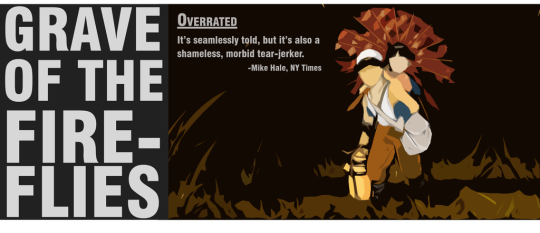
3. My Neighbor Totoro
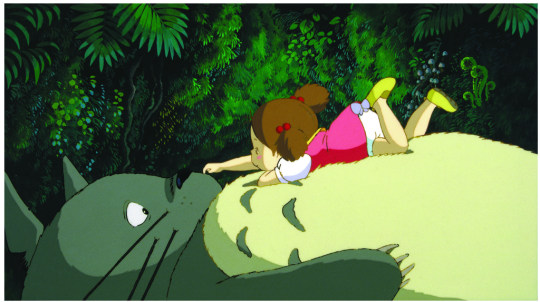
It's often said that nothing really happens in My Neighbor Totoro—but that's part of the magic of the film. A child's movie in all ways, including in the action, which revolves around a sick mother, a move to a new house, and a lost child, the film finds its center in a magical being that never says a word (Totoro only growls), and about whom many theories abound. If Totoro is a figment of Satsuki and Mei's imaginations, he is then similar to Winnie the Pooh, a necessary presence in the lives of a child character (two of them, sisters, in this case) who is growing up in a difficult situation, not to adulthood, but to the next step in the journey of life.
2. Spirited Away

Miyazaki has retired and unretired several times—when did so following Princess Mononoke, he returned with what is often considered his magnum opus, Spirited Away. At once deeply Japanese and completely accessible, the movie takes viewers on one of the most remarkable visual journeys ever put to film, a feast that never relents through its entire run time. Perhaps underrated is Miyazaki's decision to move the action away from the bathhouse for much of the final act, a quiet last leg that is key to Chihiro's journey, as well as for many of Spirited Away's supporting characters. Absolutely deserving of all love and acclaim.
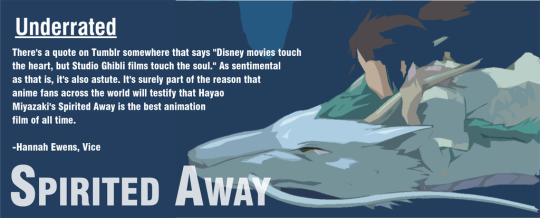
1. Princess Mononoke
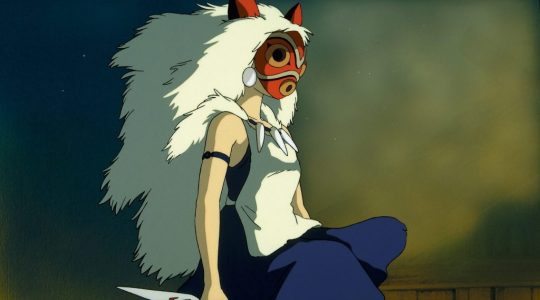
Studio Ghibli's finest film is also perhaps its most surprising. Visceral, violent, and conflicting, Princess Mononoke is no easy tale to absorb. There is no "good guy," not in the traditional sense, as Miyazaki explores hist favored ecological theme but through the lens of humanity struggling to survive in a world where they are just surpassing nature, the beast gods and goddesses who had previously ruled. It is an epic in the vein of films from decades before with vibrant and complex characters, ground-breaking animation, and an English voice track that is second to none. The studio's most intricate work, Princess Mononoke requires multiple viewings to fully appreciate.
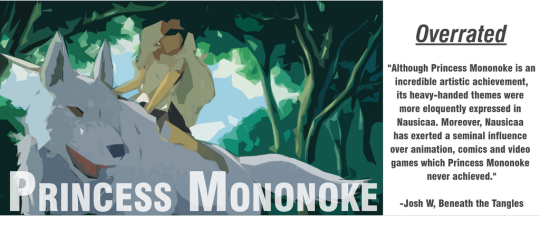
--
All Studio Ghibli movies are available for sale, including many in special collectible editions. We encourage you to go check them out!
157 notes
·
View notes
Text
Powerful Tools For Accelerating Your Productivity.
We all have goals. Moreover, most of us probably have a set of personal goals as well as a list of professional goals. But what we often don’t have are the tools and understanding to create a realistic and actionable plan that will get us from where we are today to our desired destination.
This post presents three tools, Selective Focus, Creative Ownership and Pragmatic Growth, that are designed to get you from point A to point Z with focused determination. The practices related to these three tools will help you block out distractions, use your energy to its fullest and increase your creative productivity.
At the end of this post, you’ll be on your way to tossing out your to-do lists and charting a practical route to making your dreams come true.
Mental energy is precious, so learn to say no in order to protect this resource
If you spend your days interacting with a computer, there’s a good chance you’ve encountered those times when you just feel stuck, staring at your computer screen. The more you try to get unstuck, the less you feel able to make any decisions. This is due to the fact that, when your mind is exhausted, no amount of time or effort spent on contemplation can help.
The key to avoiding this kind of exhaustion is to have mental energy, as this is what allows you to be enthusiastic and enjoy what’s going on in your professional and personal lives. But while it may be important, mental energy is also scarce and easily depleted.
According to a 2007 study in the Harvard Business Review, the average person enjoys only two hours of peak mental focus every day, along with an additional five hours of relatively high mental focus. At all other times, there’s a good chance your mental focus will be relatively poor.
So, how do we make sure our mental energy gets replenished each day? A 2012 study by medical researcher Taeko Sasai suggests that sufficient sleep is what’s needed for this to happen. But even then, with high mental energy and especially peak mental energy being such limited resources, it’s clear we need to treat each minute with care.
And that’s where Selective Focus comes in. Selective Focus is about being careful and choosy about how you spend your energy, and the first rule is learning how to say no to certain things that are competing for your attention. After all, you can’t give your time and energy to everyone, no matter how politely they ask.
Saying no doesn’t always come easily or naturally. Many of us were programmed as children to say yes to whatever our parents or our teachers asked of us. When you said yes growing up, you were probably rewarded with attention, praise or even a big, welcoming hug.
But now that you’re an adult, there are rewards to saying no. Through analyzing over 80 studies that looked into the benefits of saying no, psychologist Martin Hagger found conclusive evidence that it not only helps people avoid wasteful and unproductive activity, it also helps them achieve their goals more efficiently.
Deliberate Practice and focus are what lead to success, whereas busyness leads to mediocrity.
If you’re interested in mastering a new skill, you may have heard that it takes around 10,000 hours of practice. This may be true, but you can’t just pile on one consecutive hour of practice after another and expect to reap the rewards. Those hours need to be filled with Deliberate Practice, which is the second rule of Selective Focus.
In 1993, psychologist K. Anders Ericsson used deliberate practice to illustrate the difference between average achievement and exceptional achievement. He found that it was the hours people spent on deliberate, high-quality practice that made the difference.
More precisely, Ericsson found that while average achievers worked more hours overall, they would also engage in a lot of non-constructive practice over an entire day. Exceptional achievers, on the other hand, would only engage in deliberate practice, which might consist of one burst of concentrated energy in the morning and another one in the afternoon. This would add up to just three and a half hours of practice a day, but it was more effective than an entire day’s worth of meandering practice.
One of the things that keeps us away from deliberate practice and continually engaged in non-constructive or unfocused activities is that we tend to find certain distractions pleasurable.
Activities like checking email or tidying up your desk can trigger a dopamine release that makes these usually unproductive tasks seem more rewarding than the ones that are aligned with your long-term goals. While such activities may make you feel like you’re “keeping busy,” they can be highly counterproductive if you’re supposed to be preparing your business plan for that upcoming loan meeting.
In fact, rather than keeping busy, it would be better to stop what you’re doing. That way you can think clearly and plan the next steps that will help you reach your goal.
Be warned, though, that if you don’t “look busy,” someone may see this as an opportunity to dump work on you. This is why it’s important to protect your free time as well as your Deliberate Practice time.
If you’re ever unsure about when to say yes or no to a task, ask yourself: Is this going to bring me closer to the goals I’ve set for myself? If not, then it’s probably best to say no.
Other people’s opinions are contagious, and negative influences are bad for your brain.
Getting a cancer diagnosis can send you searching for answers. You will probably reach out to friends, doctors and therapists, asking everyone for their opinions on how best to fight the disease.
While it’s natural to seek advice when things get tough, it’s also important to be selective in this regard as well, because the attitudes and opinions of others can be infectious and sometimes harmful.
According to a 2010 study from the Proceedings of the Royal Society, being around someone with a positive attitude can improve your own outlook by 11 percent. However, being around someone with a negative attitude can make your own outlook more negative by a whopping 50 percent.
If you don’t want that to happen, you have to be highly selective about the opinions to which you expose yourself, which is why this is the third rule of Selective Focus.
This can make a big difference in your achievements, because if the people around you call your dreams unrealistic, or think you’ll never have the skills to achieve your goals, you’ll probably start thinking that there’s no point in even trying. So it’s best to keep such pessimists at a distance while surrounding yourself with an ambitious and upbeat crew.
If that’s not reason enough to do so, consider the fact that negative influences can even be harmful to your brain.
According to Stanford University biology professor Robert Sapolsky, studies have shown that after listening to 30 minutes of negative speech, the neuron cells located in the hippocampus begin dying. And this is the part of the brain related to problem-solving, so those are definitely neurons worth keeping!
A study from 2013, published in the Journal of Social and Personal Relationships, found similar results. After researchers asked people either to ignore or to listen to someone’s four-minute-long negative rant, they found that the “ignoring” participants were better than the listeners at subsequently solving thought and concentration exercises.
Write about what you know, and use the Disney method to write more freely.
The second tool is Creative Ownership, which is about freeing yourself up so that you’re working toward your own goals and no one else’s.
One of the primary ways of achieving Creative Ownership is to produce and market your own content. Now, you may be thinking that that sounds great, but that whenever you try to write, the results aren’t so hot.
If you have writer’s block, there’s a good chance it’s due to trying to write about something of which you have no experience. That’s why one of the best pieces of writing advice is to write about what you know.
Try starting by simply writing about what happened to you yesterday. Then go a little deeper by detailing one or two childhood experiences that have stuck with you. When you start to get the hang of writing from your own experience, you can graduate to hearing stories from other people and trying to write those down, and over time you’ll be able to write comfortably about yourself and others.
To help expand your creative side and really get production moving along, you can make use of the Disney method.
Named, of course, after the animation pioneer Walt Disney, the Disney system was outlined in a 2015 study by University of Munich media studies professor Sarah Tausch, and it is aimed at helping both individuals and groups to boost their production.
An important first step is to turn off the nagging inner editorial voice that says your ideas stink or that last sentence was terrible. You’re going to start off with a first draft, so feel free to write whatever comes to mind, regardless of how little sense it makes.
When you move to the second draft, turn your inner editor back on, but only at partial strength. This draft should take the good sections from the first draft, the bits that do make sense, and expand on them in paragraphs that come together in a coherent way.
Then there’s the third and final draft, in which you crank the inner editor to full power by streamlining your story, cutting repetitive bits and any parts that ruin the flow. After this draft you should have an engaging and well-formed text.
So, first is overcoming writer's block by silencing your editor and letting the words flow freely and easily. Then you hone in and expand on the good ideas before finalizing and finessing your final draft. Eventually, you’ll regularly be able to produce creative content that is interesting and high-quality.
Use lead magnets to build up your customer base, and find out what your customers are interested in
In the quest for independent Creative Ownership, one of the most valuable assets to have is a loyal customer base. The question is, how do you gain customers when you’re just starting out?
One great tool for getting customers’ attention is lead magnets. A lead is essentially customer information, so a lead magnet is something that attracts customers and compels them to give you their details. If you’re a writer, a good lead magnet might be a site where you post your first book chapter for free and potential customers can provide their email to be the first to know when the rest of the book is published.
Let’s say you’re running your own lifestyle improvement business. A good lead magnet may be a blog that regularly provides general tips that show you’re an expert in your field and that you provide quality service. You can also use customer information collected through your blog to send people newsletters and updates when a new post is published.
Lead magnets generally offer something of value for free, so in this department you should expect to operate at a loss, but keep in mind that leads may boost revenue in the long run, and can even add up to their own product. For example, all those tips on your blog can eventually be turned into a book.
The eventual goal of writing a book can serve as good motivation to update your blog regularly. This is also important because your site’s ranking on Google depends on how often you add written content; the more content, the higher you’ll be ranked in search results.
Google can also help you to figure out what customers like most about your business, which in turn can help you to pick the most effective lead magnets for new customers.
Google Analytics and other website tools can show you which blog posts or web pages on your site are getting the most views. If you’re putting that book together, this can help you decide which articles to include. It’s also great to know which lifestyle tips people are most interested in, since you can then plan future articles that expand and follow-up on these topics.
If you find that all of your popular articles are about one topic, this is a clear sign that you may have found a good niche. For example, if your audience is overwhelmingly interested in tips on how to become a successful businesswoman, then you can focus on such articles and end up with a book called Lifestyle Tips Every Businesswoman Needs to Know.
A pragmatic mindset is helpful for health and success, and this includes keeping your negativity bias in check
A pragmatic outlook can be useful in many situations. After the James was given his cancer diagnosis, life quickly became stressful, and that’s when he realized that the way forward was to be pragmatic, and focus on small, doable actions that would improve his condition.
A pragmatic outlook is not only good for your health, it can do wonders for your success as well, which is why the third tool of intelligent achievement is Pragmatic Growth.
Pragmatic Growth is essentially about increasing your ability to be pragmatic. The hallmarks of being pragmatic are being proactive and relying on realistic plans – especially in emotionally charged situations. It’s also a great way to overcome self-doubt and thoughts like, “I’ll never be able to finish this.” In these moments, pragmatism can help you focus on small, doable tasks and get you back on track to reaching your goals.
Studies also show that pragmatism is a good defense against stress. In research published in 2008, psychologist Francis Flynn found pragmatists in general to be happier and more emotionally stable than other people. During times of stress, their happiness levels didn’t decline steeply, as was noted in participants who lacked pragmatism.
Other studies have also shown how a pragmatic approach can keep the tides of negativity at bay. According to psychologist Rick Hanson, everyone has a negativity bias, or a tendency to focus more on unpleasant things than pleasant ones. His study showed that our brains will immediately store negative information in our memories, whereas positive information requires at least 12 seconds of focused attention for it to be stored. This is why we tend to remember the person who didn’t hold the elevator door open for us, but quickly forget the kindness of the person who did.
But once you know about the negativity bias, you can take pragmatic steps to correct it and keep it from interfering with your goals.
A 2008 study in the Personality and Social Psychology Bulletin shows that your negativity bias is likely to sabotage your success if you don’t take steps against it. You can set regular small tasks to help with this very purpose, like making sure not to dwell on bad moments, and not only recognizing good ones, but taking at least 12 seconds to appreciate them.
To-do lists are a waste of time, and learning to say no is the pragmatic way to avoid a long to-do list
How do you feel about to-do lists? Are they a useful tool for staying on top of things? Or are they a daily reminder of all the things you wanted to do but never got around to?
Well, if you’re not a big fan of to-do lists, you may be happy to hear that part of Pragmatic Growth is about accepting that to-do lists are often a waste of time. The truth is, making lists rarely leads to the kind of direct action that moves you closer to your goals.
In a 2012 study, biologist Mones Abu-Asab found that a big problem with most to-do lists is that they’re made up of unrelated and dissimilar tasks. Some might take a few minutes, while others might take weeks to complete. And since people like the satisfaction of ticking off a completed task, they’ll focus on small tasks, while bigger ones, like preparing your business plan, linger and die on the vine.
Staying away from distracting to-do lists filled with small tasks once again comes down to saying no and staying focused on the work that will clearly get you closer to your goal.
You can even set your default response to incoming requests to no. Or use the rule of three and only accept incoming requests if the person asks three times, since it probably means you’re the only one who can help.
You’ll also find it helpful to say no in the right way. According to a 2012 study by Vanessa Patrick, making excuses while saying no won’t help you in the long run; stating clearly that you don’t want to take on a new task is empowering and shows that you have more important work to do.
There are eight pitfalls that will stop you from being productive.
In his role at the helm of countless productivity workshops, jack has worked with thousands of people who’ve helped him identify eight pitfalls to pragmatic productivity. You can think of the tips to avoiding these pitfalls as the ultimate tool kit for keeping you on the road to Intelligent Achievement.
The first pitfall is accepting gifts. As the saying goes, there’s no such thing as a free lunch, because chances are the person picking up the tab is looking for a favor. This doesn’t mean you need to be cynical and think everyone is selfish, but if you do get invited to lunch, it doesn’t hurt to question the motives and wonder whether it isn’t, say, just a ploy to get you to work overtime. In short: pay for your own lunch.
The second pitfall is not having a morning routine. Having a regular morning routine is great for reducing the amount of mental energy you use, since you don’t have to make any decisions – everything can just go like clockwork. This means you’ll have more mental energy to spend on more important tasks later in the day.
Third is the mistake of prioritizing busywork. Always focus on the big goals and taking the steps that get you there.
Similarly, the fourth pitfall is prioritizing easy tasks over difficult ones. Don’t do it!
Pitfall number five is to be overly reliant on the eight-hour workday. Remember, you only have five hours of high-level mental energy available. So it’s all about being efficient and focused during these hours while spending the rest of the time resting and recuperating.
The sixth and seventh pitfalls are the ever-present distractions of smartphones and incoming email. Constantly checking social media, texts and email wastes mental energy. Avoid these pitfalls at all costs.
The final pitfall is giving in to requests from others. Again, this is about becoming comfortable with saying that magical two-letter word: No.
So there you have it: the three tools for Intelligent Achievement are Selective Focus, Creative Ownership and Pragmatic Growth. Now it’s time to apply these tools to your life and accelerate your career with smart, Deliberate Practice
Intelligent Achievement is about attaining your goals with the use of smart, focused practices, and the tools for doing so are within anyone’s reach. Once you focus your attention on what’s truly important in reaching those goals, you can begin to filter out distractions, including people with distracting requests and negative attitudes. You can then become more independent, creative and productive with tools like the Disney method, and use lead magnets to help you gain customers. The final tool is to be more pragmatic by being aware of your negativity bias, and taking small, realistic steps that will add up to major life goals.
Action plan: Hone your creative voice by listening to others. Finding a voice that connects with your audience is about combining your interests with things that resonate with the public. You can start doing this today by talking to your friends about a topic that interests you and seeing how they react. Maybe a different but closely related topic is more interesting to them? Take in this information, and try to write a new article that incorporates your views as well as those of your friends and target audience.
0 notes
Text
Self-Assessment #3
Self-Assessment of Entire Quarter
In the beginning of the quarter, my strengths in writing was my well-crafted diction. When I had something of substance to write about, I could easily crunch out enough pages to call it a solid essay. However, the opposite of this also applied to me as well - if I did not have interest in the topic or anything substantial to write about, I would be stuck for days staring at a blank paper. One of my biggest weaknesses was not being able to properly outline and execute a paper by the deadline. Writing for me came in sporadic bursts of energy; I’d have to wait until I got the burst, until which the creative juices would finally start flowing. This problem was magnified in this paragraph of my first RA essay draft:
“In juxtaposition to character narratives, Whitehead places an equal significance on setting and location. Whitehead begins his story with character narratives, then follows it with the location. The book itself is named after the infamous “Underground Railroad”, which is remembered for its location in Northern United States with routes to Canada, Mexico, and Caribbean Sea (Society). Already from the title, we know that location plays an important role in the development of Whitehead’s story. For example, in the chapter “Ridgeway”, Whitehead describes the backstory of a slave catcher named Ridgeway. He describes his upbringing in a white supremacist environment. He shows us how and why he becomes the slave catcher he is today. Following this chapter, Whitehead then describes the story of Cora and her escape from Ridgeway. Whitehead integrates characteristics of Ridgeway’s character into how he views slaves like Cora. (Whitehead) Whitehead ties a character portrait to a specific location, which then allows readers to put context into where these characters are coming from and their setting.”
This is an excerpt from my first RA draft about narrative structure in the Underground Railroad. I remember particularly that this paragraph was one of the worst paragraphs in the essay, because I did not have enough substance to back up my main point, and so my writing was equivalent to that of a middle schooler. I did not use sophisticated diction or syntax, provide any evidence to back up my points, or analyze the text as much as I could have. This bad writing was largely due to my lack of outlining the essay beforehand; it was mostly just free writing with no preparation prior to writing the draft.
I realized that my bad habit of not outlining my essay would catch up to me. So during my second revision of my RA, I decided to create an intensive outline, which looked like this:
Introduction
State selected rhetorical device
Explain what effect of complex narrative, what it does, how it situates with history of genre
Integrate narrator’s presence
Body paragraphs
Describe components of neo slave and how it relates to text
Use examples and background information
Topic sentence, explicate quote for reader
PIE
Point - state thesis
Illustration - use quote
Explanation - explain use of quote
Body paragraph #1
Character narrative
Ajarry
Cora
Caesar
Ridgeway
Ethel + Jasmine
Stevens
Body paragraph #2
Location / setting
Central Africa
Georgia
North Carolina
Tennessee
Body paragraph #3
How Whitehead connects character and location
Themes he uses in both narratives that create one continuous storyline
Conclusion
Whitehead alternates between character and location
His purpose of doing this, how he does it, and what effect it has
Notes
Chapters about stories: reveals how slavery racism affects groups of people Connects characters to a certain environment Creates context for readers Illustrates how a certain character’s trait impacts the stigma of slavery Examples: Ridgeway growing up hating blacks > slave catcher > how this affects Cora, Ethel growing up with Jasmine > may be lesbian, has maternal instinct to take care of black people out of burden (white man’s burden)
Under each outline point, I wrote my paragraphs based on the skeleton that I had created. This forced me to incorporate more sources into my paragraphs as evidence, create more structure in each paragraph, and form smoother transitions from one paragraph to the next. It even made me realize that I had to change my entire thesis in order to craft a better RA. Going through this painful experience of writing, revising, erasing, changing my thesis, revising again made me become a better writer.
I utilized this method of outlining my essay with my new RIP essay. With this RIP essay, I had much more creative freedom in my topic. I knew that this creative freedom would be an advantage for me because when I am passionate about my writing, I am able to write a lot better and faster than I would with other essays. I outlined my RIP essay, chose the sources that I needed to use, then wrote the first draft all in a couple of hours. Outlining my essay beforehand made it even more efficient to write the essay. The process of writing my RIP was a lot smoother than my experience of writing the RA. I think it was because I was able to use the methods that I had learned from writing the RA in this new RIP.
Particularly, one of my favorite excerpts of writing from this quarter is my conclusion in my RIP essay:
“Malcolm X is often misunderstood. The separatist “prophet of rage”, the violent civil rights leader that white Americans loathed: these are the flattened caricatures that people liked to see him as. But Malcolm was much more than that. He was not the rival against Martin Luther King Jr; he was the complementary civil rights force needed to balance with King. King was for peace, and Malcolm was for violence. King would not be able to fight equality with peace alone, and Malcolm’s violent methods would be catastrophic to the movement (X 256). But despite these differences, both men shared one trait that leveraged the civil rights movement into the right direction: passion. What really matters is the difference that they made for all blacks in American society, not the way they achieved their goals. Without these two leaders, the black community would not be where it is today.”
The reason why I liked this conclusion so much was because I actually explicated further on the topic, and incorporated my own philosophical opinion into it. I didn’t just sum up my essay, but I was able to expand more on why my topic is so significant to today’s society. I hadn’t done this in my RA essay, and I noticed that it did not have the same resonance as my RIP essay has now.
Overall, I think my writing has improved in regards to my outlining and formulating the plan of my essay. However, I think that my syntax and diction still has room for improvement. I also think that I should work on analyzing things in more detail, and not just succumbing to merely summarizing the plot.
0 notes
Photo

*Presented by www.chachachawdhary.com, the new era of on line shopping) powered by ARMAendeavor Retail Private Limited (on line E-Commerce services provider ) and BCD technologies (www.bcdtech.in )
Body painting, or sometimes body painting, is a form of body art. Unlike tattoo and other forms of body art, body painting is temporary, painted onto the human skin, and can last several hours or many weeks (in the case of mehndi or "henna tattoos") about two weeks. Body painting that is limited to the faceis known as face painting. Body painting is also referred to as (a form of) "temporary tattoo"; large scale or full-body painting is more commonly referred to as body painting, while smaller or more detailed work can sometimes be referred to as temporary tattoos.
* Visit à www.chachachawdhary.com (to buy best quality products at lowest on line price in India)
Indigenous
Body painting with clay and other natural pigments existed in most, if not all, tribalist cultures. Often worn during ceremonies, it still survives in this ancient form among the indigenous people of Australia, New Zealand, the Pacific islands and parts of Africa. A semi-permanent form of body painting known as Mehndi, using dyes made of henna leaves (hence also known rather erroneously as "henna tattoo"), was and is still practiced in India], especially on brides. Since the late 1990s, Mehndi has become popular amongst young women in the Western world.
*Subscribe our You Tube Chennel :- ChachaChawdhary
Many indigenous peoples of Central and South America paint Jagua Tattoos, or designs with Genipa Americana juice on their bodies. Indigenous peoples of South America traditionally use annatto, huito, or wet charcoal to decorate their faces and bodies. Huito is semi-permanent, and it generally takes weeks for this black dye to fade.[1]
Actors and clowns around the world have painted their faces—and sometimes bodies—for centuries, and continue to do so today. More subdued form of face paints for everyday occasions evolved into the cosmetics we know today.
*Follow us on Twitter : chachaonline1
Western
Body painting is not always large pieces on fully nude bodies, but can involve smaller pieces on displayed areas of otherwise clothed bodies. There has been a revival of body painting in Western society since the 1960s, in part prompted by the liberalization of social mores regarding nudity and often comes in sensationalist or exhibitionist forms. Even today there is a constant debate about the legitimacy of body painting as an art form. The current modern revival could be said to date back to the 1933 World's Fair in Chicago when Max Factor, Sr. and his model Sally Rand were arrested for causing a public disturbance when he body-painted her with his new make-up formulated for Hollywood films. Body art today evolves to the works more directed towards personal mythologies, as Jana Sterbak, Rebecca Horn, Youri Messen-Jaschin, Jacob Alexander Figueroa or Javier Perez.
Body painting is sometimes used as a method of gaining attention in political protests, for instance those by PETA against Burberry.
Body painting led to a minor alternative art movement in the 1950s and 1960s, which involved covering a model in paint and then having the model touch or roll on a canvas or other medium to transfer the paint. French artist Yves Klein is perhaps the most famous for this, with his series of paintings "Anthropometries". The effect produced by this technique creates an image-transfer from the model's body to the medium. This includes all the curves of the model's body (typically female) being reflected in the outline of the image. This technique was not necessarily monotone; multiple colors on different body parts sometimes produced interesting effects.
Joanne Gair is a body paint artist whose work appeared for the tenth consecutive year in the 2008 Sports Illustrated Swimsuit Issue. She burst into prominence with an August 1992 Vanity Fair Demi's Birthday Suit cover of Demi Moore. Her Disappearing Model was part of an episode of Ripley's Believe It or Not!.
*Follow us on Linkdine :- https://www.linkedin.com/in/chachachawdhary/
Festivals
Body painting festivals happen annually across the world, bringing together professional body painters as well as keen amateurs. Body paintings can also typically be seen at football matches, at rave parties, and at certain festivals. The World Body painting Festival in Pörtschach (previously held in Seeboden) in Austria is the biggest art event in the body-painting theme and thousands of visitors admire the wonderful work of the participants.
Body painting festivals that take place in North America include the North American Body Painting Championship, Face and Body Art International Convention in Orlando, Florida, Bodygras Body Painting Competition in Nanaimo, BC and the Face Painting and Body Art Convention in Las Vegas, Nevada.
Australia also has a number of body painting festivals, most notably the annual Australian Body Art Festival in Eumundi, Queensland, and the Australian Body Art Awards
In Italy, the Rabarama Skin Art Festival (held every year during the Summer and Autumn, with a tour in the major Italian cities), is a different event focused on the artistic side of body painting, highlighting the emotional impact of the painted body in a live performance more than the decorative and technical aspects of it. This particular form of creative art is defined "Skin Art".
*Visit to Tumblr :- https://chachachawdhary.tumblr.com/
Fine art
The 1960s supermodel Veruschka is a much-appreciated muze for body paint artists. Images of her in the book Transfigurations by photographer Holger Trulzsch have frequently been emulated. Other well-known works include Serge Diakonoff's books A Fleur de Peau and Diakonoff and Joanne Gair's Paint a licious. More recently Dutch art photographer Karl Hammer has taken center stage with his combinations of body painting and narrative art (fantastic realism)
Following the already established trend in Western Europe, body painting has become more widely accepted in the United States since the early 1990s. In 2006 the first gallery dedicated exclusively to fine art body painting was opened in New Orleans by World Body painting Festival Champion and Judge, Craig Tracy. The Painted Alive Gallery is on Royal Street in the French Quarter. In 2009, a popular late night talk show Last Call with Carson Dalyon NBC network, featured a New York-based artist Danny Setiawan who creates reproductions of masterpieces by famous artists such as Salvador Dalí, Vincent van Gogh, and Gustav Klimt on human bodies aiming to make fine art appealing for his contemporaries who normally would not consider themselves as art enthusiasts.
Since 2005 the Australian visual artist Emma Hack has been creating photographs of painted naked human bodies that visually merge with a patterned background wall inspired by the wallpaper designs of Florence Broad Hurst. Hack is best known for the Gotye music video for the song Somebody That I Used to Know, which uses stop-motion animation body painting and has received over 800 million views on YouTube.[11] Hack now creates her own canvas backgrounds and her work is often featured with live birds, representing nature. Hack's artworks are exhibited worldwide.
*Follow us on Pinterest : https://in.pinterest.com/chachaonline1/
In Commercial Arena
Many artists work professionally as body painters for television commercials, such as the Natrel Plus campaign featuring models camouflaged as trees. Stills advertising also used body painting with hundreds of body painting looks on the pages of the world's magazines every year. Body painters also work frequently in the film arena especially in science fiction with an increasing number of elaborate alien creations being body painted. One of the more notable commercial body paint artists is Syl Verberk (nicknamed 'syllie faces') who, as a two time European champion and winner of various prizes, is frequently consulted by major companies and theme parks for their advertisements and designs. Other celebrated commercial artists are Guido Daniele, Jean-Paul Bourdierand the Australian company "Human Statue Bodyart".
The Sports Illustrated Swimsuit Issue, published annually, has frequently featured a section of models that were body painted, attired in renditions of swimsuits or sports jerseys. Also Playboy magazine has frequently made use of body painted models. In the 2005 Playmates at Play at the Playboy Mansion calendar, all Playmates appeared in the calendar wearing bikinis, but Playmates Karen McDougal and Hiromi Oshima actually appeared in painted-on bikinis for their respective months.
The success of body painting has led to many notable international competitions and a specific trade magazine (Illusion Magazine) for this industry, showcasing work around the world.
*Facebook Pages : Cloths by ChachaChawdhary.Com
Face painting
Face painting is the artistic application of cosmetic "paint" to a person's face. There are special water-based cosmetic "paints" made for face painting; people should ask before having face paints applied what products are being used. Acrylic and tempera craft paints are not meant for use on skin and are not acceptable, nor are watercolor pencils or markers. Products not intended for use on skin can cause a variety of issues ranging from discomfort to severe allergic reactions. Just because the product is marked "non-toxic" does not mean it is meant to be used on the skin.
From ancient times, it has been used for hunting, religious reasons, and military reasons (such as camouflage and to indicate membership in a military unit). Recent archaeological research shows that Neanderthals had the capability and tools for face painting; although they are no longer considered a direct ancestor of Homo sapiens, they lived alongside them in some areas and it is a reasonable assumption that humanity has painted faces and bodies since the very beginning. Although it died out in Western culture after the fall of the French aristocracy, face painting re-entered the popular culture during the hippie movement of the late 1960s, when it was common for young women to decorate their cheeks with flowers or peace symbols at anti-war demonstrations. The popular TV variety show, Rowan & Martin's Laugh-In, featured bodies painted with comedic phrases and jokes during transitions.
*Facebook Group : Exclusive Girls
For several decades it has been a common entertainment at county fairs, large open-air markets (especially in Europe and the Americas), and other locations that attract children and adolescents. Face painting is very popular among children at theme parks, parties and festivals throughout the Western world. Though the majority of face painting is geared towards children, many teenagers and adults enjoy being painted for special events, such as sports events (to give support to their team or country) or charity fundraisers. Face painting is also a part of cosplay practice, and is enjoyed yearly by people who dress up as zombies to dance with the annual worldwide "Thrill the World" event on the Saturday before Halloween.
It is common to find if someone is dressed in an animal costume, a black nose will be added alone to give the impression of an animal face and not just body. Sometimes, a full face is added or sometimes none at all.
Most theme parks have booths scattered around where a person can have a design painted on their face. A similar activity is the application of "instant tattoos", which are paint or ink-based designs that are put on as one unit and removed by means of water, alcohol, soap, or another mild solvent. More elaborate temporary tattoos may be made using stencils and airbrush equipment
In the military
It is common in militaries all over the world for soldiers in combat scenarios to paint their faces and other exposed body parts (hands, for example) in natural colors such as green, tan, and loam for camouflage purposes. In various South American militaries, it is a tradition to use face paint on parade in respect to the indigenous tribes.
*Facebook Pages : ChachaChawdhary.com
Temporary tattoos
As well as paint, temporary tattoos can be used to decorate the body. "Glitter tattoos" are made by applying a clear, cosmetic-grade glue (either freehand or through a stencil) on the skin and then coating it with cosmetic-grade glitter. They can last up to a week depending on the model's body chemistry.
Foil metallic temporary tattoos are a variation of decal-style temporary tattoos, printed using foil-stamping technique instead of ink. On the front side, the foil design is print
*Facebook Pages : New Era of Online Shopping
Body paints
Modern water-based face and body paints are made according to stringent guidelines, meaning these are non-toxic, usually non-allergenic, and can easily be washed away. Temporary staining may develop after use, but it will fade after normal washing. These are either applied with hands, paintbrush, and synthetic sponges or natural sea sponge, or alternatively with an airbrush.
Contrary to the popular myth perpetuated by the James Bond film Gold finger, a person is not asphyxiated if their whole body is painted.
Liquid latex may also be used as body paint. Aside the risk of contact allergy, wearing latex for a prolonged period may cause heat stroke by inhibiting perspiration and care should be taken to avoid the painful removal of hair when the latex is pulled off.
*Facebook Group : New Era of Online Shopping
The same precautions that apply to cosmetics should be observed. If the skin shows any sign of allergy from paint, its use should immediately be ceased. Moreover, it should not be applied to damaged, inflamed or sensitive skin. If possible, a test for allergic reaction should be performed before use. Special care should be paid to the list of ingredients, as certain dyes are not approved by the US FDA for use around the eye area—generally those associated with certain reddish colorants, as CI 15850 or CI 15985—or on lips, generally blue, purple or some greens containing CI 77007. More stringent regulations are in place in California regarding the amount of permissible lead on cosmetic additives, as part of Proposition 65.In the European Union, all colorants listed under a CI number are allowed for use on all areas. Any paints or products, which have not been formulated for use on the body, should never be used for body or face painting, as these can result in serious allergic reactions.
*Facebook Pages : Travel Addiction
As for Mehndi, natural brown henna dyes are safe to use when mixed with ingredients such as lemon juice. However, a commonly marketed product called "black henna", is not safe to use because the product has been made by mixing natural henna with synthetic black dyes containing PPD, which can cause serious skin allergies, and should be avoided due to the substantial risk of serious injury. Another option is Jagua, a dark indigo plant-based dye that is safe to use on the skin and is approved for cosmetic use in the EU.
*Facebook Pages : True Property
Hand art
"Hand art" is the application of make-up or paint to a hand to make it appear like an animal or other object. Some hand artists, like Guido Daniele, produce images that are representations of wild animals painted on people's hands.
Hand artists work closely with hand models. Hand models can be booked through specialist acting and modeling agencies usually advertising under "body part model" or "hands and feet models".
Disclaimer : We as team ARMAendeavor Retail Private Limited , www.chachachawdhary.com and www.bcdtech.in don’t have any intentions to spread Nudity or Vulgarity
This Blog is only an effort to make society and people aware about Body paint as a Art ,we are not responsible of any copy write or law related Issues as pictures , videos are copied ,contents are an effort of our research team .
Author : is Well known Writer and Social and Public activist and Re noun Entrepreneur
0 notes